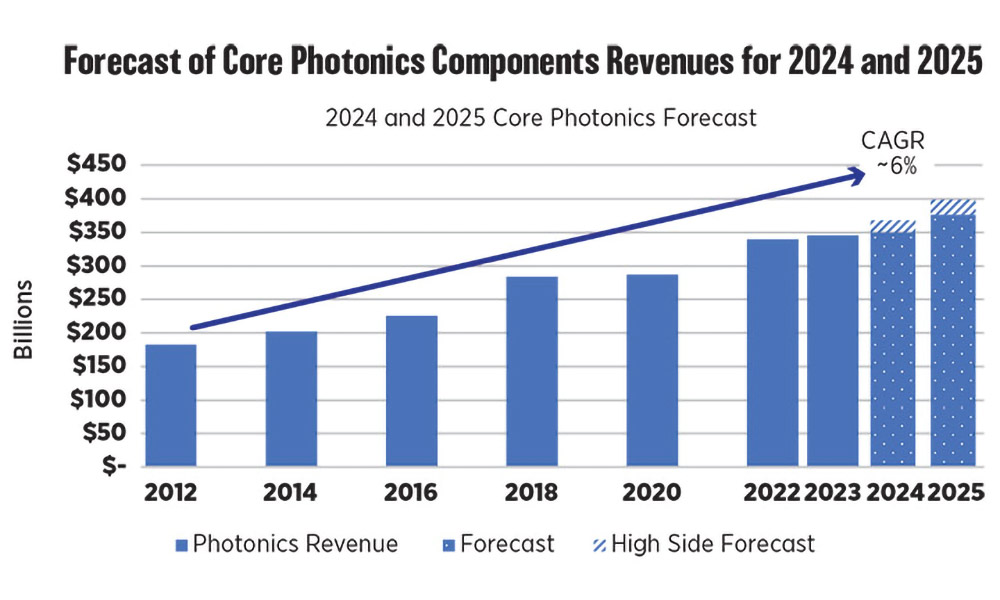
Core optics and photonics components underpin a global market for photonics-enabled products that is projected to exceed $2.5 trillion for 2024, highlighting the ongoing strength and importance of the photonics industry. That’s according to the SPIE 2025 Optics and Photonics Global Industry Report, which reveals that global annual revenues from the production of optics and photonics core components have grown at a pace approaching 6% compound annual growth rate for the last decade, reaching $345 billion in 2023. According to the industry analysis, accelerating innovation coupled with a diverse range of light-enabled applications markets has pushed the growth of photonics technology revenues to consistently outpace gains in global gross domestic product (GDP). Since 2012, the photonics components industry has grown at a rate more than twice that of global GDP.
“All of us working in photonics understand how light-based technologies and products underpin so much of the global economy, but it is vital for us to get that message out to policymakers and investors,” says SPIE CEO Kent Rochford. “At SPIE, it’s key to our mission to advocate for the industry, and the data found in the report is key to helping get that message out.”
The SPIE report—presented each year at the SPIE Global Business Forum—draws on the Society’s industry expertise, world-class database, and global footprint. For more than a decade, the report has tracked metrics like the number of companies, distribution of global revenues, jobs based on company headquarters, and more, painting a picture of solid growth for the photonics industry.

As defined in this 11th edition of the Industry Report, core photonics components underpin all light-enabled products and services like smartphones, computers, laser-based instruments for industrial and medical applications, cloud computing, streaming content services, and e-commerce.
Estimates of the total monetary value of all light-enabled products and related services exceed 19% (about $20 trillion) of worldwide economic output. Core photonics components range from raw materials to image sensors, and from light-emitting diodes to lasers. By focusing on the core components and the companies that produce them, SPIE has leveraged its comprehensive understanding of the photonics ecosystem to characterize the global photonics industry. With 13 years of accumulated data, the report delivers a unique perspective on the thriving global ecosystem of photonics components manufacturing, the companies involved, where they are headquartered, their revenues, and the number of jobs created globally by optics and photonics components production. Other key findings of the report include:
SPIE tracked and evaluated 4,923 companies that produced core photonics components in 2023, 86% of which are small to medium enterprises (SMEs). “Although most of the companies are SMEs, the larger entities generate the majority of the revenues. In fact, only ~6% of all companies, including such household names as Samsung, Corning, Nikon, and Carl Zeiss, generated more than 86% of total revenues in 2023,” SPIE reports.
To examine the global distribution of photonics revenue, SPIE follows a methodology that captures each company’s global revenues in the local currency of the country where it is headquartered and then converts them to US dollars for global comparison purposes. For 2023, the report reveals that, the top five revenue-producing countries were the US, Japan, South Korea, China, and Taiwan. The predominance of large photonics components manufacturers headquartered in Japan—such as Keyence, Nikon, Olympus, Panasonic, Sony, and Sharp—means that Japan’s share of total photonics components revenues is very high. Together, companies headquartered in the US and Japan account for more than half of the total global components revenues.
The report notes that the core photonics components industry “has grown to the point that combined demand for lasers and all other photonics components in 2023 underwrote more than 1.3 million jobs worldwide. As employment has grown, so has the number of countries hosting components manufacturers, making it a truly global industry.”
In all, the report notes, the global photonics industry has experienced more than a decade of consistent growth despite headwinds like chip shortages, regional conflicts, rising costs, and a global pandemic.
William G. Schulz is Managing Editor of Photonics Focus.